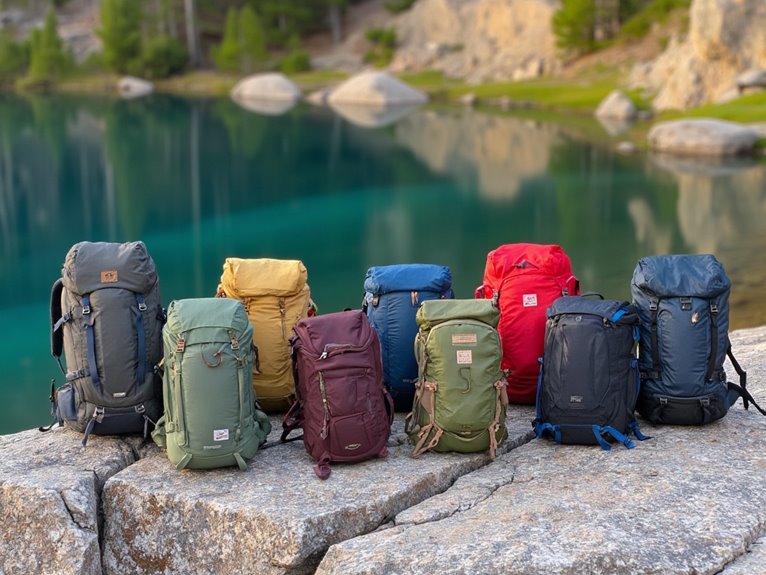What Size Backpack for 2 Months?
For a two-month trip, choosing the right backpack size is vital. A 40-50 liter capacity backpack is ideal, allowing for a comfortable and efficient packing strategy. This size enables you to carry essential items while avoiding overpacking. Effective packing strategies, such as the 3-2-1 rule, rolling clothes, and using quick-drying fabrics, maximize backpack capacity. By understanding space allocation and adopting a minimalist approach, you can fit everything you need into a smaller backpack. To optimize your packing list and learn more about efficient packing strategies, delve into the nuances of packing for an extended trip.
We are supported by our audience. When you purchase through links on our site, we may earn an affiliate commission, at no extra cost for you. Learn more. Last update on 15th January 2026 / Images from Amazon Product Advertising API.
Factors to Consider When Packing
When preparing for an extended trip, pragmatism is key, and it's essential to ponder several key factors that will substantially impact the efficacy of your packing strategy. Weather conditions, cultural norms, and activity levels are pivotal considerations that will influence the types and quantities of items to pack. Additionally, the mode of transportation, accommodation type, and personal preferences will also shape your packing list. It's essential to strike a balance between packing light and bringing essential items, ensuring you're prepared for unexpected situations. By carefully evaluating these factors, you'll be able to create a thoughtful and efficient packing strategy that meets your unique needs, ensuring a successful and enjoyable trip.
Choosing the Right Backpack Size
A backpack's capacity, measured in liters, is a critical factor in determining its suitability for a 2-month trip, as it directly affects the quantity of gear that can be comfortably carried. When choosing the right backpack size, consider the type of gear you need to bring, the duration of your trip, and your personal packing style. A larger backpack may seem appealing, but it can be cumbersome and heavy, making it difficult to maneuver in tight spaces. On the other hand, a smaller backpack may not provide enough space for all your essentials. Finding the right balance is key. By considering your specific needs and preferences, you can select a backpack that meets your requirements without compromising on comfort and mobility.
Backpack Capacities for Two Months
When planning a two-month backpacking trip, it's vital to ponder the ideal load size to guarantee a comfortable and manageable pack. Effective packing strategies are critical in maximizing backpack capacity, and understanding how to allocate space efficiently is key. By adopting a thoughtful approach to packing, travelers can make the most of their backpack's capacity, minimizing unnecessary items while still carrying the essentials.
Packing Strategies
How much gear can you realistically carry for two months, and what are the implications for backpack capacity? A key consideration is the 3-2-1 rule: three tops, two bottoms, and one dressier outfit. This minimalist approach allows for a smaller backpack while still providing adequate clothing for the duration. Roll your clothes to save space and consider quick-drying, moisture-wicking fabrics. Pack multipurpose items, such as a sarong or travel towel, to reduce overall weight. By prioritizing essential items and using space-saving techniques, you can efficiently utilize your backpack's capacity. Aim to fill your backpack to 70-80% capacity, leaving room for souvenirs and flexibility in your packing strategy. Effective packing strategies can substantially impact your overall backpack capacity requirements.
Optimal Load Size
By adopting a minimalist packing approach, travelers can realistically aim to carry a backpack with a capacity of 40-50 liters for a two-month trip. This size range allows for efficient packing while still accommodating essential items. When choosing a backpack, consider the following key factors:
- Volume: A 40-50 liter capacity is ideal for two months of travel, providing ample space for clothing, gear, and souvenirs.
- Weight distribution: Look for a backpack with comfortable shoulder straps and a hip belt to distribute the load evenly.
- Compartments: Multiple compartments and pockets help keep gear organized and easily accessible.
- Durability: Select a backpack made from high-quality, durable materials that can withstand the rigors of extended travel.
Packing Strategies for Efficiency
A well-curated packing list, paired with a thoughtful folding and rolling strategy, forms the foundation of efficient backpacking for extended periods. By strategically packing items, you can maximize space, reduce clutter, and access what you need quickly. Utilize packing cubes or compression bags to separate and compress clothing, and consider a "bundle wrap" technique to organize loose items. To optimize vertical space, place heavier or less frequently used items at the bottom of the backpack, with essentials like passport and first-aid kit easily accessible. By adopting these strategies, you'll be able to efficiently carry all you need for a two-month journey, while minimizing bulk and hassle.
Activity-Specific Gear and Clothing
Depending on your planned activities, you'll need to pack specific gear and clothing to guarantee a comfortable and enjoyable experience. For instance, if you're planning to hike, you'll need sturdy hiking boots and trekking poles. If you're going to engage in water activities, bring a wetsuit or rash guard.
Some essential items to think about packing include:
- Hiking boots or trail running shoes
- Swimwear or a wetsuit
- Cycling gear, such as a helmet and gloves
- Yoga mat or exercise equipment for fitness enthusiasts
Remember to prioritize the activities you'll be doing most frequently and pack accordingly. This will help you strike a balance between packing light and being prepared for your adventures.
Climate and Weather Considerations
Climate and weather conditions can greatly impact your travel experience, making it crucial to research and prepare for the environments you'll encounter during your two-month journey. Understanding the climate and weather patterns of your destinations will help you pack accordingly. For hot and humid climates, consider packing lightweight, breathable clothing and sun protection. In cold climates, prioritize warm, insulating layers and waterproof gear. Don't forget to research any extreme weather events, such as monsoons or hurricanes, and plan accordingly. By considering climate and weather, you can guarantee you're prepared for any situation, keeping your travels safe and enjoyable.



